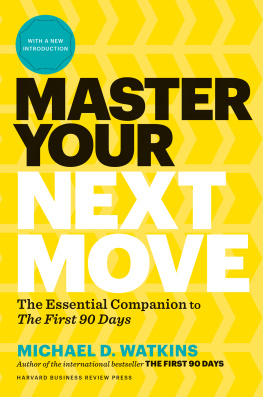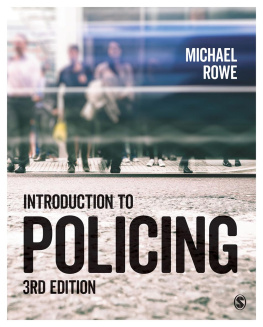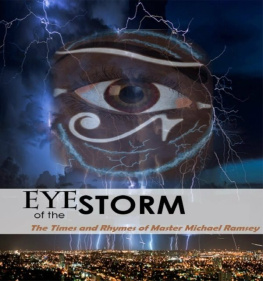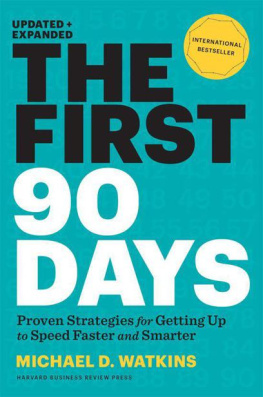Michael D. Watkins - Master Your Next Move, with a New Introduction
Here you can read online Michael D. Watkins - Master Your Next Move, with a New Introduction full text of the book (entire story) in english for free. Download pdf and epub, get meaning, cover and reviews about this ebook. year: 2019, publisher: Harvard Business Review Press, genre: Business. Description of the work, (preface) as well as reviews are available. Best literature library LitArk.com created for fans of good reading and offers a wide selection of genres:
Romance novel
Science fiction
Adventure
Detective
Science
History
Home and family
Prose
Art
Politics
Computer
Non-fiction
Religion
Business
Children
Humor
Choose a favorite category and find really read worthwhile books. Enjoy immersion in the world of imagination, feel the emotions of the characters or learn something new for yourself, make an fascinating discovery.
- Book:Master Your Next Move, with a New Introduction
- Author:
- Publisher:Harvard Business Review Press
- Genre:
- Year:2019
- Rating:5 / 5
- Favourites:Add to favourites
- Your mark:
- 100
- 1
- 2
- 3
- 4
- 5
Master Your Next Move, with a New Introduction: summary, description and annotation
We offer to read an annotation, description, summary or preface (depends on what the author of the book "Master Your Next Move, with a New Introduction" wrote himself). If you haven't found the necessary information about the book — write in the comments, we will try to find it.
Master Your Next Move, with a New Introduction — read online for free the complete book (whole text) full work
Below is the text of the book, divided by pages. System saving the place of the last page read, allows you to conveniently read the book "Master Your Next Move, with a New Introduction" online for free, without having to search again every time where you left off. Put a bookmark, and you can go to the page where you finished reading at any time.
Font size:
Interval:
Bookmark:

HBR Press Quantity Sales Discounts
Harvard Business Review Press titles are available at significant quantity discounts when purchased in bulk for client gifts, sales promotions, and pemiums. Special editions, including books with corporate logos, customized covers, and letters from the company or CEO printed in the front matter, as well as excerpts of existing books, can also be created in large quantities for special needs.
For details and discount information for both print and ebook formats, contact .
Copyright 2019 Michael D. Watkins
All rights reserved
No part of this publication may be reproduced, stored in or introduced into a retrieval system, or transmitted, in any form, or by any means (electronic, mechanical, photocopying, recording, or otherwise), without the prior permission of the publisher. Requests for permission should be directed to , or mailed to Permissions, Harvard Business School Publishing, 60 Harvard Way, Boston, Massachusetts 02163.
First eBook Edition: Apr 2019
ISBN: 978-1-63369-760-7
eISBN: 978-1-63369-761-4
To my mother, Denise,
whose courage and resilience
inspire me always.
Successful careers as a series of challenging transitions into new roles. Mapping the different types of transitions. Diagnosing your particular personal adaptive and organizational change challenges so you know what you are up against.
Understanding what success looks like at a higher level in the hierarchy. Adjusting your focus and approach to delegation. Developing new leadership competencies and cultivating presence.
Being promoted to manage people who were formerly your peers. Deftly establishing your authority in the new role. Reengineering existing relationships. Dealing with problematic former peers.
Moving from a position of authority to one in which strong influence skills are critical for getting things done. Mapping the influence landscape. Building supportive alliances.
Joining a new organization and adapting to a new culture. The pillars of effective onboarding. Building the right political wiring. Aligning expectations up, down, and sideways.
Moving to a new country and leading people in an unfamiliar culture. Moving ones family and rebuilding the support system. Preparing for entry. Beginning to engage with the team and the business.
Taking over an organization that is in deep trouble and figuring out how to save it from destruction. Diagnosing the situation, designing the business model, driving alignment, and dynamically adapting.
Confronting an organization that is in denial about the need for change. Creating a sense of urgency before problems simmering below the surface erupt in a crisis. Adjusting your leadership style to match the situation.
Leading an organization in which different parts are in different states: start-up, turnaround, accelerated growth, realignment, and sustaining success. Figuring out where to focus and how to build momentum.
Understanding the critical transitions taking place throughout companies. Building unified transition acceleration systems. Adjusting for types of transitions. Deploying through coaching, programs, and e-learning.
Many of the examples used throughout this book were inspired by conversations Ive had with leaders in transition. One outstanding leader in particular, Mark Clouse, offered a wealth of insight into the challenges of international transitions, and the chapter on that challenge draws on our many discussions. Other executives whose experiences contributed substantially to this work include Oray Boston, Harald Emberger, Barbara Schwartz, Rick Searer, Doug Soo Hoo, and Bas van Buijtenen. Many thanks to them for sharing their thoughts and recommendations for improving the manuscript.
I refined the ideas about types of transitions through my participation in IMDs Orchestrating Winning Performance (OWP) program and in discussions with my colleagues there. Many thanks to Bala Chakravarthy, Carlos Cordon, Dan Denison, Albrecht Enders, Robert Hooijberg, Peter Killing, Jean-Franois Manzoni, Don Marchand, Maury Peiperl, Stuart Read, David Robertson, Phil Rosenzweig, Paul Strebel, and Jack Wood.
Many thanks to Jeff Kehoe and Roberta Fusaro at Harvard Business Publishing. Jeff has been a strong advocate for my work for many years and is a highly valued adviser. Roberta is one of the most gifted editors Ive ever had the pleasure to work with.
Finally, thank you to my colleagues at Genesis who labored hard to build a business that brought these ideas to life, and tested and proved them in our products and coaching processes.
Transitions into new roles are the most challenging times in the professional lives of leaders. Thats a bold statement, but its true and backed up by more than a decade of research and practice. If you are successful in rapidly scaling the learning curve, building key relationships, and getting early wins, your momentum will propel you through the rest of your time in your new role. But early missteps can create bad first impressions, leading to negative feedback loops in which you look increasingly unsuited for the job. Left unchecked, you could end up in a downward spiral it might be difficult or impossible to recover from.
I wrote The First 90 Days, the book for which Master Your Next Move is the essential companion and resource guide, because Id seen too many leaders get into needless trouble early on in their new roles. They made common mistakesnot learning enough about their new organizations culture and politics, coming in with the answer, trying to do too much too soon, not aligning expectationsand they paid the inevitable price in derailment or underperformance.
.
The First 90 Days Framework
To succeed in a new role, you must:
- Accelerate your learning. Efficient and effective learning is a necessary foundation for making a successful transition. The faster you learn about the technical, cultural, and political dimensions of your new position or assignment, the more youll be able to accomplish in the critical first months.
- Match strategy to situation. Different types of business situations require you to make significant adjustments in how you approach your transition. A clear assessment of the business situation is an essential prerequisite for developing your transition plan.
- Negotiate success. You need to figure out how to build a productive working relationship with your new manager (or managers). This means planning for a series of critical conversations about the situation, expectations, working style, and resources.
- Achieve alignment. Armed with a deeper understanding of the business situation, your managers expectations, and the interests of key stakeholders, you can define your vision and core objectives. Then you can develop your strategy to realize that vision and achieve your goals.
- Build your team. Like most leaders taking on a new role, you probably dont get to build your own team; instead, you inherit your predecessors. You must rapidly assess and reshape the team, and then align, organize, and energize it to achieve your goals.
- Secure early wins.
Font size:
Interval:
Bookmark:
Similar books «Master Your Next Move, with a New Introduction»
Look at similar books to Master Your Next Move, with a New Introduction. We have selected literature similar in name and meaning in the hope of providing readers with more options to find new, interesting, not yet read works.
Discussion, reviews of the book Master Your Next Move, with a New Introduction and just readers' own opinions. Leave your comments, write what you think about the work, its meaning or the main characters. Specify what exactly you liked and what you didn't like, and why you think so.













